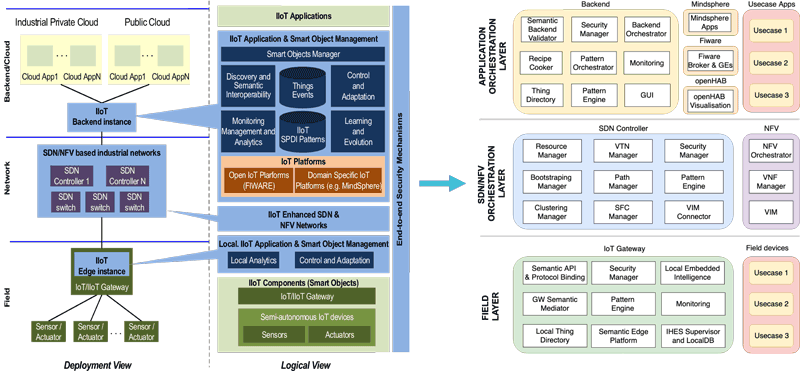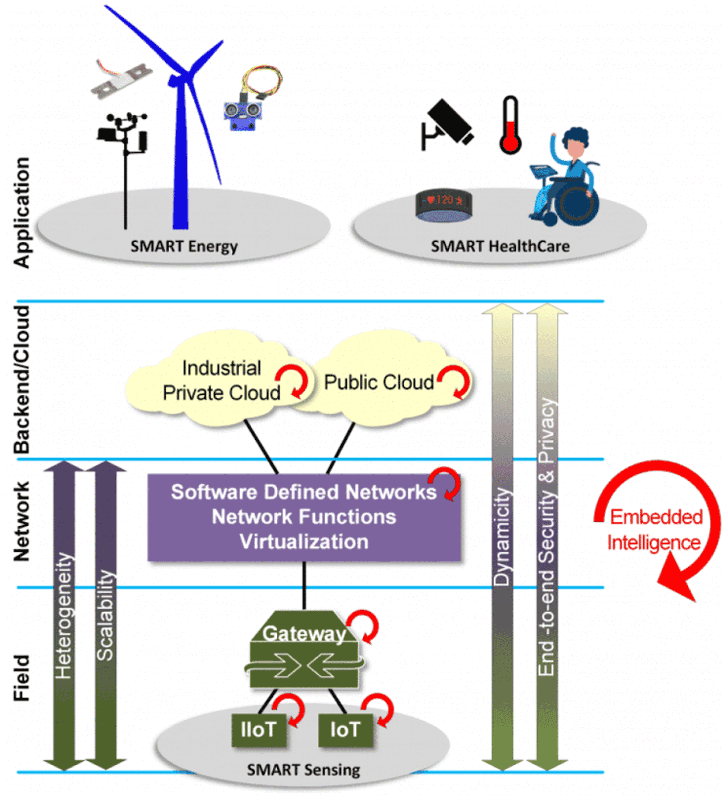by Nikolaos Petroulakis (FORTH), Konstantinos Fysarakis (Sphynx), Sotiris Ioannidis (FORTH), George Spanoudakis (Sphynx) and Vivek Kulkarni (Siemens)
Next generation networks, such as the Internet of Things (IoT), aim to create open and global networks for connecting smart objects, network elements, applications, web services and end-users. Research and industry attempt to integrate this evolving technology and the exponential growth of IoT by overcoming significant hurdles such as dynamicity, scalability, heterogeneity and end-to-end security and privacy. SEMIoTICS proposes the development of a pattern-driven framework, built upon existing IoT platforms, to enable and guarantee secure and dependable actuation and semi-autonomic behaviour in IoT/IIoT applications.
The introduction of digital technologies in economic and societal processes is key to addressing economic and societal challenges such as ageing of population, ensuring societal cohesion, and sustainable development. While the fifth generation (5G) mobile communications are already upon us, the next steps in their evolution will be key in supporting this societal transformation, while also leading to a fourth industrial revolution that will impact multiple sectors.
IoT appears to be an important pillar of 5G. Global networks like IoT create enormous potential for new generations of IoT applications, by leveraging synergies arising through the convergence of consumer, business and industrial internet, and creating open, global networks connecting people, data, and “things”. A series of innovations across the IoT landscape have converged to make IoT products, platforms and devices technically and economically feasible. However, despite these advances, significant business and technical hurdles must be overcome before the IoT’s potential can be realised.
Some important challenges and complexities include:
- Sustaining massively generated, ever-increasing, network traffic with heterogeneous requirements
- Adaptation of communication technologies for resource-constrained virtualised environments
- Provision of networking infrastructures featuring end-to-end connectivity, security and resource self-configuration
- Trusted information sharing between tenants and host systems.
Overcoming these challenges requires the implementation and deployment stack of IoT applications. The overall aim of SEMIoTICS [L1] is to develop a pattern-driven framework [1-2], built upon existing IoT platforms, to enable and guarantee secure and dependable actuation and semi-autonomic behaviour in IoT/IIoT applications. The SEMIoTICS framework supports cross-layer intelligent dynamic adaptation, including heterogeneous smart objects, networks and clouds. To address the complexity and scalability needs within horizontal and vertical domains, SEMIoTICS develops and integrates smart programmable networking and semantic interoperability mechanisms.
The SEMIoTICS architectural framework (Figure 1) has been envisaged and developed for efficient interconnectivity of smart objects. Each layer contains specific developed modules able to handle different aspects and guarantee different properties. More specifically, Software Defined Networking (SDN) Orchestration layer provides data and control plane decoupling resulting in a cloud computing approach that facilitates network management and enables programmatically efficient network configuration meeting different IoT application requirements related to security, bandwidth, latency and energy efficiency, using semantic information. Network Function Virtualization (NFV) Orchestration layer provides a flexible, programmable, dynamic and scalable networking paradigm, making it ideal for satisfying the QoS demands of SEMIoTICS use cases. Field layer is responsible for hosting all types of IoT devices such as sensors and actuators as well as IoT gateway which provides common way for communication and ensures enforcement of SPDI patterns in this layer. Finally, Application Orchestration layer consists of all applications receiving the communication from field layer.

Figure 1: SEMIoTICS (i) envisaged architecture (ii) developed architecture.
The above is validated by industry, using three diverse usage scenarios in the areas of renewable energy, healthcare, and smart sensing (Figure 2) and will be offered through an open API.
- Use Case 1 - Smart Energy: This use case will showcase IIoT integration in Wind Park Control Network providing value added services such as local smart behaviour, predictive maintenance and monitoring etc. Current state of the art of Wind Turbine Controller in a Wind Park control network is typically an embedded or highly integrated operating system, which rigorously follows development and pre-qualification prior to deployment in the real world. Because of this slow process, new features, adding new sensors, actuators and related advancements require several months or even years to be fully matured and operational in the field.
- Use Case 2 – Smart Health Care: This use case employs the SEMIoTICS technologies to develop an Information and Communication Technology (ICT) solution aimed at sustained independence and preserved quality of life for elders with mild cognitive impairment or mild Alzheimer’s disease, with the overall goal of delaying institutionalisation: supporting both “aging in place” (individuals remain in the home of choice as long as possible) and “community care” (long-term care for people who are mentally ill, elderly, or disabled provided within the community rather than in hospitals or institutions).
- Use Case 3 - Smart Sensing: This use case offers an interesting specular approach to this scenario (influenced by “Edge Computing” or “Pervasive Computing”). The main assumption is that intelligent data processing shall take place at sensor level, and that distributed data classification and clustering is a key aspect for massive system scalability. Moreover, in this use case algorithms derived from AI techniques will be deployed at Gateway, down to MCU level, also allowing the system to online/self-learn from the environment. The latter is a quite challenging aspect in itself in the AI field.

Figure 2: SEMIoTICS Use Cases.
SEMIoTICS is an IoT Security/Privacy Cluster European Union project funded under the H2020-IoT-03-2017 work programme, with Grant Agreement number 780315.
Link:
[L1]: http://www.semiotics-project.eu
References:
[1] N. E. Petroulakis, et al.: “SEMIoTICS Architectural Framework: End-to-end Security, Connectivity and Interoperability for Industrial IoT”, in 2019 IEEE Global IoT Summit (GIoTS), 2019.
[2] K. Fysarakis, et al.: “Architectural Patterns for Secure IoT Orchestrations”, in 2019 IEEE Global IoT Summit (GIoTS), 2019.
Please contact:
Nikolaos Petroulakis, ICS-FORTH, Greece,











